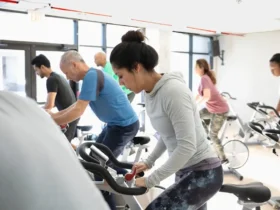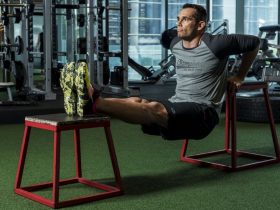In the world of fitness, High-Intensity Interval Training (HIIT) has become one of the most popular and effective workout methods. Renowned for its ability to deliver impressive results in a short amount of time, HIIT has earned its place as a go-to training style for those looking to burn fat, build endurance, and improve overall fitness. But with its fast pace and intense intervals, HIIT can be intimidating for beginners. Whether you’re new to exercise or looking to try something different, understanding the principles of HIIT and how to approach it correctly can help you reap the full benefits without overwhelming yourself.
This beginner’s guide aims to demystify HIIT, offering insights into how it works, what to expect, and how to craft a workout routine that suits your needs.
1. What Is HIIT?
High-Intensity Interval Training, or HIIT, is a workout style that alternates between short bursts of intense exercise and periods of lower-intensity recovery or rest. The idea is to push your body to its maximum effort during the high-intensity phases, followed by a brief period of recovery. This cycle is repeated multiple times in a single session.
A typical HIIT workout lasts anywhere from 15 to 30 minutes, making it an incredibly efficient training method for those with busy schedules. The beauty of HIIT lies in its versatility: exercises can range from bodyweight movements like jumping jacks, burpees, and push-ups, to more complex exercises using equipment like dumbbells, kettlebells, or stationary bikes.
What makes HIIT effective is the principle of “afterburn,” scientifically known as excess post-exercise oxygen consumption (EPOC). After a HIIT workout, your body continues to burn calories at an elevated rate as it recovers, resulting in a greater overall calorie burn even after you’ve finished exercising. This is why HIIT is often praised for its fat-burning benefits and its ability to improve cardiovascular fitness in a relatively short amount of time.
2. Why HIIT Works: The Science Behind It
The secret to HIIT’s success lies in its ability to challenge both your aerobic (endurance) and anaerobic (strength) energy systems. By pushing your heart rate up during the high-intensity intervals, you engage your cardiovascular system, improving heart health and stamina. In the recovery phases, your body replenishes its energy stores and stabilizes its heart rate, allowing you to sustain multiple rounds of intense effort.
HIIT also activates fast-twitch muscle fibers, which are responsible for explosive movements like sprinting or jumping. These fibers play a crucial role in building muscle and increasing metabolic rate. Over time, HIIT helps increase muscle tone while simultaneously reducing fat, making it an excellent option for those looking to improve body composition.
Moreover, HIIT is time-efficient. Studies show that HIIT can produce the same, if not better, results compared to traditional steady-state cardio exercises (like jogging) but in a fraction of the time. This is ideal for people with busy schedules who want to maximize their workouts.
3. Is HIIT Right for You?
Before jumping into a HIIT routine, it’s important to assess your fitness level and health status. While HIIT can benefit people of all fitness levels, beginners should be mindful of their current conditioning and start with less intense intervals to avoid overexertion. If you’re new to exercise or have any health concerns (such as heart issues or joint problems), it’s always a good idea to consult a healthcare provider before beginning a HIIT program.
Additionally, if you’re a beginner, don’t feel compelled to perform high-intensity exercises right away. HIIT can be modified to fit your needs. You can start with lower-intensity exercises or increase the recovery periods between intervals as you gradually build your fitness.
4. How to Get Started with HIIT as a Beginner
If you’re ready to dive into HIIT, here’s how to get started in a way that is both effective and manageable:
1. Warm Up Properly
Before beginning any workout, warming up is essential. A proper warm-up helps prepare your muscles, joints, and cardiovascular system for the intensity to come, reducing the risk of injury. Spend at least 5 to 10 minutes on dynamic stretches and light cardio, such as brisk walking, jogging, or cycling. This will gradually increase your heart rate and get your blood flowing.
2. Start with Short Intervals
As a beginner, it’s important not to overdo it right away. Start with shorter bursts of high-intensity work (about 20-30 seconds) followed by longer recovery periods (around 1-2 minutes). This allows you to perform the exercises with good form and intensity while giving your body time to recover.
A beginner-friendly approach might look like this:
-
30 seconds of work: Jumping jacks
-
1 minute of rest
-
30 seconds of work: Bodyweight squats
-
1 minute of rest
-
Repeat for 15-20 minutes
As you get stronger, you can gradually increase the work period and decrease the rest period to increase the intensity of your workouts.
3. Choose Simple, Effective Exercises
Begin with exercises that target large muscle groups and focus on bodyweight movements. These exercises are easier to master, and they help build strength and endurance without requiring equipment. Good examples include:
-
Squats
-
Lunges
-
Push-ups
-
Jumping jacks
-
Mountain climbers
-
Burpees (optional as you progress)
If you feel ready to incorporate equipment, consider resistance bands, dumbbells, or kettlebells for added challenge.
4. Listen to Your Body
HIIT is intense by nature, so it’s crucial to listen to your body and take breaks when needed. If you feel dizzy, lightheaded, or unable to maintain good form, take a rest. Consistency over time is key—pushing yourself too hard too soon could lead to burnout or injury.
5. Cool Down and Stretch
After your HIIT session, always cool down with light cardio (such as walking or gentle cycling) followed by static stretches. This helps lower your heart rate gradually and aids in recovery. Focus on stretching the muscles you worked, paying special attention to your quads, hamstrings, and upper body.
5. How Often Should You Do HIIT?
As a beginner, aim to start with 2-3 HIIT sessions per week, allowing at least one day of rest between each workout. This gives your body time to recover and adapt to the new training intensity. Once your fitness improves, you can increase the frequency of your sessions, but it’s crucial to balance HIIT with other types of exercise, such as strength training, yoga, or low-intensity cardio, to avoid overtraining.
It’s also important to note that rest is just as important as the workout itself. Your muscles need time to repair and rebuild, which is when the real fitness gains happen. So don’t skip your rest days.
6. Tracking Progress and Staying Motivated
As with any workout routine, consistency is key to seeing results with HIIT. Track your progress by recording the exercises you perform, the duration of your intervals, and how your body feels after each session. Celebrate small victories, such as improving your form, increasing the number of intervals, or feeling less fatigued during recovery.
Stay motivated by varying your routine. You can experiment with different exercises, increase your intensity as you get fitter, or even try different formats, such as circuit-style HIIT or sprint intervals.
7. The Benefits of HIIT Beyond Fat Loss
While many people turn to HIIT for its fat-burning benefits, the advantages extend far beyond just weight loss. Consistent HIIT training helps improve cardiovascular health, increase muscle tone, and boost metabolism. Additionally, research suggests that HIIT can enhance insulin sensitivity, improve mental clarity, and even reduce stress levels. It’s a full-body workout that strengthens not only your muscles but also your mental fortitude.
Conclusion
HIIT workouts are an efficient and effective way to transform your fitness routine, but getting started as a beginner requires a thoughtful approach. By starting slow, focusing on the fundamentals, and listening to your body, you can gradually build the stamina and strength needed to tackle more challenging sessions. Whether you’re looking to lose weight, build muscle, or simply boost your cardiovascular health, HIIT can help you reach your goals. Embrace the intensity, stay consistent, and you’ll see that HIIT workouts really do work—no matter your fitness level.









